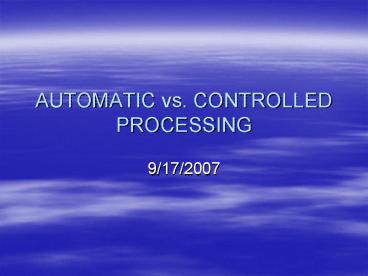AUTOMATIC vs. CONTROLLED PROCESSING - PowerPoint PPT Presentation
1 / 23
Title:
AUTOMATIC vs. CONTROLLED PROCESSING
Description:
Researchers like John Bargh returned to the idea of unconscious processing ... Supraliminal. Bargh, Chen, & Burrows (1996, study 2) ... – PowerPoint PPT presentation
Number of Views:668
Avg rating:3.0/5.0
Title: AUTOMATIC vs. CONTROLLED PROCESSING
1
AUTOMATIC vs. CONTROLLED PROCESSING
- 9/17/2007
2
Context
- Idea of automatic processing is old and new
- Freuds notion of the unconscious
- Researchers like John Bargh returned to the idea
of unconscious processing - Background processing that eases the burden for
conscious processing
Its just a cigar, I swear!
3
Distinguishing Automatic from Controlled Processes
- Conditions for automaticity
- Lack of awareness
- Conversely, if we are aware of processing, it is
controlled - Efficiency
- Lack of conscious intent
- Lack of control
4
Lack of Awareness
- Bargh, Chen, Burrows (1996)
- Scrambled sentence task
- Form four word sentences out of five words
provided - Ex he it hides finds instantly
- 3 conditions neutral, rude, or politeness prime
- Rude they her bother usually
- Polite they her respect usually
- Go tell experimenter when finished
5
Bargh, Chen Burrows 1996
- Results?
- Supraliminal
6
Bargh, Chen, Burrows (1996, study 2)
- Participants completed scrambled sentence task
- Neutral version
- Elderly version (old, bingo, wrinkle, retired)
- Told that experiment was completed
- How long to walk 9.75 m to elevator (exit)?
7
Bargh, Chen, Burrows (1996)
- Results?
8
Lack of awareness
- Subliminal Priming
- Logic if participants cant detect stimulus,
they cant possibly be aware of the influence of
the stimulus on their behavior! - RATS demo
- http//openyoureyes.web1000.com/index.php?p1_6
9
Kunst-Wilson Zajonc (1980)
- Participants subliminally exposed to geometric
figures
10
Kunst-Wilson Zajonc (1980)
- 2 questions
- Which shape have you seen before?
11
Kunst-Wilson Zajonc (1980)
- Results?
- Participants couldnt identify previously seen
shape (48 chance) - However, participants did show a preference for
previously seen shape! (60 choice) - Dubbed mere exposure effect
12
Subliminal Demo
- E-prime demo
13
Efficiency
- By definition, controlled processes use
attentional resources, whereas automatic
processes do not - Therefore, if we introduce a cognitive load,
controlled processes should be affected, whereas
automatic processes are unaffected - Cognitive load examples
- Remember this 8-digit number
- Count backwards from 100 by 3
14
Gilbert, Pelham, Krull (1988)
- Automatic and controlled processing in
attribution - Internal attribution conclude that the reason
for persons behavior is dispositional - He pushed me because he is aggressive
- External attribution conclude that the reason
for a persons behavior is due to situation - He pushed me because he tripped into me
15
Gilbert, Pelham, Krull (1988)
- Participants listen to proabortion or
antiabortion speech - Speaker was assigned to take one side of issue
- Cog. Load manipulation
- half of participants thought that they too would
give a speech (load) - Other half did not need to rehearse speech (no
load) - Automatic effect make internal attributions
based on speech - Controlled effect correct for situation (i.e.,
person was assigned to position, may not be true
position)
16
Gilbert, Pelham, Krull (1988)
- Results?
17
Lack of Conscious Intent
- Automatic processes result from environmental
stimuli, not conscious intentions to process
information - Thus, a good way to show that a process is
unintended is to set up a situation where the
stimulus suggests one mode of processing
(automatic), but where we intend to use another
mode (controlled) - Stroop task
18
The Stroop Effect
Please name the colors
19
The Stroop Effect
Please name the colors
RED
RED
BLUE
YELLOW
GREEN
YELLOW
RED
BLUE
BLUE
GREEN
RED
RED
BLUE
YELLOW
GREEN
GREEN
YELLOW
BLUE
YELLOW
GREEN
20
Variations of the Stroop task
- Emotional Stroop task (e.g., Gotlib McCann,
1984) - Depressed vs. Non-depressed participants
- Asked to say color of presented word
- Some of the words were related to depression
- Ex low, sad, miserable
- Results non-depressed participants were
unaffected depressed participants were
significantly slower when responding to
depression-related words
21
Lack of Control
- If a process occurs, even when we are trying to
avoid the process from occurring (exercising
control), then the process must be automatic - Ironic processing (Wegner, 1994)
- Dont think about White Bears
22
Believing the Unbelievable
- Spinoza and the acceptance/rejection of
information - Acceptance is automatic
- Rejection is controlled
- Gilbert, Krull, and Malone (1990)
- Participants exposed to true and false statements
- Ex Armadillos deplore raisin cookies
- Some trials included a distraction (pressing a
button when tone sounded) - Predictions When we have the resources, we will
be able to distinguish true and false statements
equally well however when we are distracted, the
automatic process will be unaffected (acceptance
of information), while control processes are
23
Gilbert, Krull, Malone (1990)
- Results?































